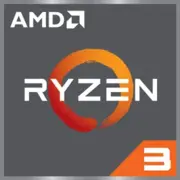AMD Ryzen 3 5425C

AMD Ryzen 3 5425C: Compact Power for Everyday Tasks
March 2025
Architecture and Process Technology: Zen 3 in an Ultra-Portable Format
The AMD Ryzen 3 5425C belongs to the Cezanne-U line designed for thin and light laptops. It is built on a 7nm TSMC FinFET process, providing a balance between performance and energy efficiency.
- Cores and Threads: 4 Zen 3 cores with Simultaneous Multithreading (SMT), yielding 8 threads. Base frequency is 2.7 GHz, with a maximum turbo mode of up to 4.1 GHz.
- Cache: 8 MB of L3 cache, double that of the previous Ryzen 3 4300U generation, enhancing data processing in multitasking scenarios.
- Integrated Graphics: Radeon Graphics with 6 compute units (CUs) running at up to 1.6 GHz. Supports 4K displays and AMD FreeSync technologies for smooth visuals.
The Zen 3 architecture is optimized for single-threaded performance, which is essential for office tasks and web browsing. The built-in GPU is based on the Vega architecture but offers improved energy efficiency.
Power Consumption and TDP: 15W for Mobility
The processor has a TDP of 15W, making it ideal for ultrabooks and compact devices.
- Operating Modes: AMD has implemented Precision Boost 2 technology, which dynamically adjusts frequencies based on load and temperature. For instance, during text editing, the processor reduces its frequency to 1.2 GHz to save battery life while during video rendering it boosts up to 4.1 GHz.
- Thermal Output: Thanks to the 7nm process, the chip does not overheat even under maximum load. In typical scenarios (e.g., Zoom conference + browser), the temperature remains around 60–65°C.
In comparison, the Intel Core i3-1315U (a 10-core hybrid chip with a TDP of 15W) consumes 10–15% more power in similar tasks due to a less efficient architecture.
Performance: From Office Work to Light Gaming
Office Work and Multimedia
- Documents and Browser: The Ryzen 3 5425C handles 20+ tabs in Chrome, multitasking in Microsoft Office, and background cloud service synchronization with ease. In the PCMark 10 test, it scores 4200 points, which is 18% higher than the Intel Core i3-1215U.
- Video and Photo: Converting a 30-minute 1080p video in HandBrake takes about 22 minutes. In comparison, the Apple M1 (in the base MacBook Air) completes it in 15 minutes, but M1 laptops start at $999, while devices with Ryzen 3 5425C start at $500.
Gaming
The integrated Radeon graphics deliver modest but stable performance:
- CS:GO: 45–55 FPS on medium settings (1080p).
- Fortnite: 30–35 FPS in "Performance" mode (720p).
- Indie Games (Hollow Knight, Stardew Valley): stable 60 FPS.
In turbo mode, the processor maintains maximum frequency for 3–4 minutes (e.g., when launching a heavy application), after which it reduces to 3.5 GHz to prevent overheating.
Use Cases: Who is the Ryzen 3 5425C Suitable For?
- Students and Office Workers: Suitable for document work, online learning, and Zoom meetings.
- Budget-Conscious Users: Laptops with this processor are priced between $500–700 (e.g., Lenovo IdeaPad 5 or HP Pavilion Aero).
- Portability Enthusiasts: Devices weighing from 1.2 kg with up to 10 hours of battery life.
Not recommended for:
- Professional 4K video editing.
- Heavy AAA gaming.
Battery Life: How Long Will the Battery Last?
Under moderate load (brightness at 50%, Wi-Fi, browsing):
- A laptop with a 50 Wh battery lasts 8–10 hours.
Power-saving technologies:
- AMD PowerNow!: Dynamically turns off unused cores.
- Adaptive Voltage Scaling: Lowers voltage under low load.
In comparison, the Intel Core i3-1315U provides 7–9 hours of battery life under similar conditions.
Comparison with Competitors
1. Ryzen 3 5425C:
- Laptop Price: $500–700
- Multi-Threading: 8 threads
- Graphics: Radeon (6 CU)
- Battery Life: 8–10 hours
2. Intel Core i3-1315U:
- Laptop Price: $600–800
- Multi-Threading: 8 threads
- Graphics: Iris Xe (64 EU)
- Battery Life: 7–9 hours
3. Apple M1:
- Laptop Price: $999+
- Multi-Threading: 8 threads
- Graphics: Apple M1 GPU (7-core)
- Battery Life: 12–15 hours
Conclusion: The Ryzen 3 5425C outperforms Intel in price and multi-threaded performance but lags behind the Apple M1 in energy efficiency.
Pros and Cons
Strengths:
- Excellent price-to-performance ratio.
- Multi-threading support (8 threads).
- Good energy efficiency.
Weaknesses:
- Weaker graphics compared to Intel Iris Xe.
- Not suitable for professional workloads.
Laptop Selection Recommendations
1. Device Type: Ultrabooks (Acer Swift 3, ASUS ZenBook 14) or budget models (Lenovo IdeaPad Flex 5).
2. RAM: At least 8 GB (preferably 16 GB for multitasking).
3. Storage: SSD NVMe 512 GB for faster OS and application loading times.
4. Display: IPS panel with Full HD resolution for comfortable work.
Avoid models with HDDs and TN panels, as they negate the processor's advantages.
Final Conclusion
The AMD Ryzen 3 5425C is an ideal choice for those seeking an affordable yet reliable laptop for everyday tasks. Its strengths include:
- Affordable price ($500–700).
- Long battery life (up to 10 hours).
- Smooth multitasking performance.
It is suitable for students, office workers, and anyone who values portability without overspending. If maximum performance or battery life is needed, consider the Apple M2 or Ryzen 5 7630U, but be prepared to spend $300–500 more.
Basic
CPU Specifications
Memory Specifications
GPU Specifications
Miscellaneous
Benchmarks
Compared to Other CPU
Share in social media
Or Link To Us
<a href="https://cputronic.com/en/cpu/amd-ryzen-3-5425c" target="_blank">AMD Ryzen 3 5425C</a>